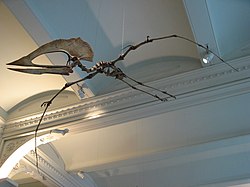Pterosaur
| Part of RationalWiki's Cryptid Petting Zoo |
| Hiding with Schrödinger's cat |
A pterosaur (from Ancient Greek pteron and saurus, meaning "winged reptile") was a member of an order of flying reptiles in existence from 228 to 66 million years ago,[1] until they met their tragic end along with three quarters of other life. Some species of the largest genera, Hatzegopteryx and Quetzalcoatlus, might have had a wingspan of over 10 metres, making them the largest known flying animals to have ever lived. They are sometimes called pterodactyls, but that only refers to the genus Pterodactylus or suborder Pterodactyloidea. They are not dinosaurs, not being in the clade Dinosauria, but are closely related.
There shouldn't be any debate over whether they are extinct, but there have been a lot of claimed modern sightings.
Claimed sightings[edit]
There have been reports of alleged pterosaurs from the US, Mexico, Crete (Greece), Namibia, and central Africa.[2]
The Young Earth Creationist, Carl Baugh, has carried out investigations trying to find evidence that that pterosaurs are still among us, having supposedly survived on Noah's Ark. His investigations in Papua New Guinea have focused on local legends of flying animals variously called ropen, indava, kor, or seklo-bali.[3] The ropen is claimed to be a large, flying, jungle-living cryptid which is associated by many creationist Christians with prehistoric flying reptiles.[4] Somewhat remarkably, many accounts claim the ropen literally glows in the dark — somewhat less remarkably no credible evidence of its existence has ever been provided.
Records of old sightings[edit]
There are claims that some works of ancient or indigenous art show pterosaurs even though they were extinct long before human beings came along. One example is in Thompson, Utah.[2]
Some suggest that myths of dragons can be attributed to and explained by historical sightings of pterosaurs. They propose that the "fire" could actually be misinterpretation of a smoke-based defence similar to the ink clouds produced by octopuses.[5] Because, naturally, a flying toothed predator — with a ten-meter wingspan — at the apex of the airborne food-chain would want to hide from ... well what?
The mass extinction[edit]
What proponents of living pterosaurs don't do a good job of explaining is how any pterosaurs managed to survive one of the largest mass extinctions in history, the K-Pg extinction event, yet have managed to remain at a stable-but-extremely low population for 66 million years. One would think that, after sticking around for so long, they would be a few more members than what necessitates only eyewitness testimonies as evidence.
Pterosaurs weren't exactly small, and the fact that they were an aerial species (as opposed to remaining submerged out in deep ocean water) suggests that there really ought to be some more concrete evidence.
Inaccuracies in fiction[edit]
Pterosaurs have featured in several films including adaptations of Sir Arthur Conan Doyle's The Lost World, the original King Kong (1933), One Million Years BC (1966), and Jurassic Park III (2001). Fictional depictions tend to be inaccurate in several respects.[6]
Their wings are typically portrayed as being bat-like, but in actuality differed in many regards. The wing surfaces were held out by only by an extremely long fourth finger with the other three staying free, whereas bats have their second-through-fifth fingers all supporting the membrane. It is also very unlikely that their wing tips were pointed as that could lead to risky stalling.[7]
Although Rhamphorhynchus![]() and other earlier pterosaurs had teeth, their later descendants did not. For instance, the popular large and crested Pteranodon,
and other earlier pterosaurs had teeth, their later descendants did not. For instance, the popular large and crested Pteranodon,![]() whose name means "toothless wing", did not have teeth despite depictions to the contrary.[1]
whose name means "toothless wing", did not have teeth despite depictions to the contrary.[1]
Only a small number of pterosaurs were piscivores despite a widespread image of them eating fish; and they did not have prehensile claws capable of picking things up and flying away.[6]
The pterosaur wing tip debacle[edit]
In April 2022 reputable paleontologist and biologist Darren Naish has raised a question about the depiction of pterosaur wings as rounded in paleoart.[8] The concern was in itself rather valid, as many paleoart trends have been noted to be exaggerated and/or idiotic, but a number of posts have cited Hone 2015[9] and other papers on the matter. This in turn has lead to a wave of goalshifting on many commenters, usually by focusing on the definition of "convex" and "lobe". This culminated in artist R.J. Palmer calling Hone "a 17 year old on deviantart".[10]
See also[edit]
External links[edit]
Some cryptozoologist sites[edit]
Go searching for sites promoting this and you're bound to come across one attributed to Johnathan David Whitcomb, which certainly explains why they promote the exact same set of books.
The following sites all bear this attribution, though some have other authors as well.
- live-pterodactyl.com, which doesn't actually confine itself to just Pterodactylus
- live-pterosaur.com and the associated blog
- livingpterosaurs.com Noticing a theme?
- Pterosaur fossils which seeks "to compare pterosaur fossils with reports of apparent pterosaurs seen as still living by eyewitnesses."[11]
- Pterosaurs still living as well as a similar page under the same directory with slightly different content
References[edit]
- ↑ 1.0 1.1 See the Wikipedia article on Pterosaur.
- ↑ 2.0 2.1 Are Pterodactyl Sightings Real? About Pterosaurs, Thought Co
- ↑ Texas and Pterosaurs, Ropens
- ↑ The “Ropen” of Papua New Guinea, Genesis Park
- ↑ Do Dragons Exhale Fire?, livepterosaur.com
- ↑ 6.0 6.1 Myths and Misconceptions, pterosaur.net
- ↑ Pterosaur flight, pterosaur.net
- ↑ https://web.archive.org/web/20220425191240/https://twitter.com/TetZoo/status/1518669123361857536
- ↑ The wingtips of the pterosaurs: Anatomy, aeronautical function and ecological implications by D. W. E. Hone et al. (2015) Palaeogeography, Palaeoclimatology, Palaeoecology 440:431-439. doi:10.1016/j.palaeo.2015.08.046.
- ↑ https://web.archive.org/web/20220426004407/https://twitter.com/arvalis/status/1518752543286824961
- ↑ Purpose of "Pterosaur Fossils"

